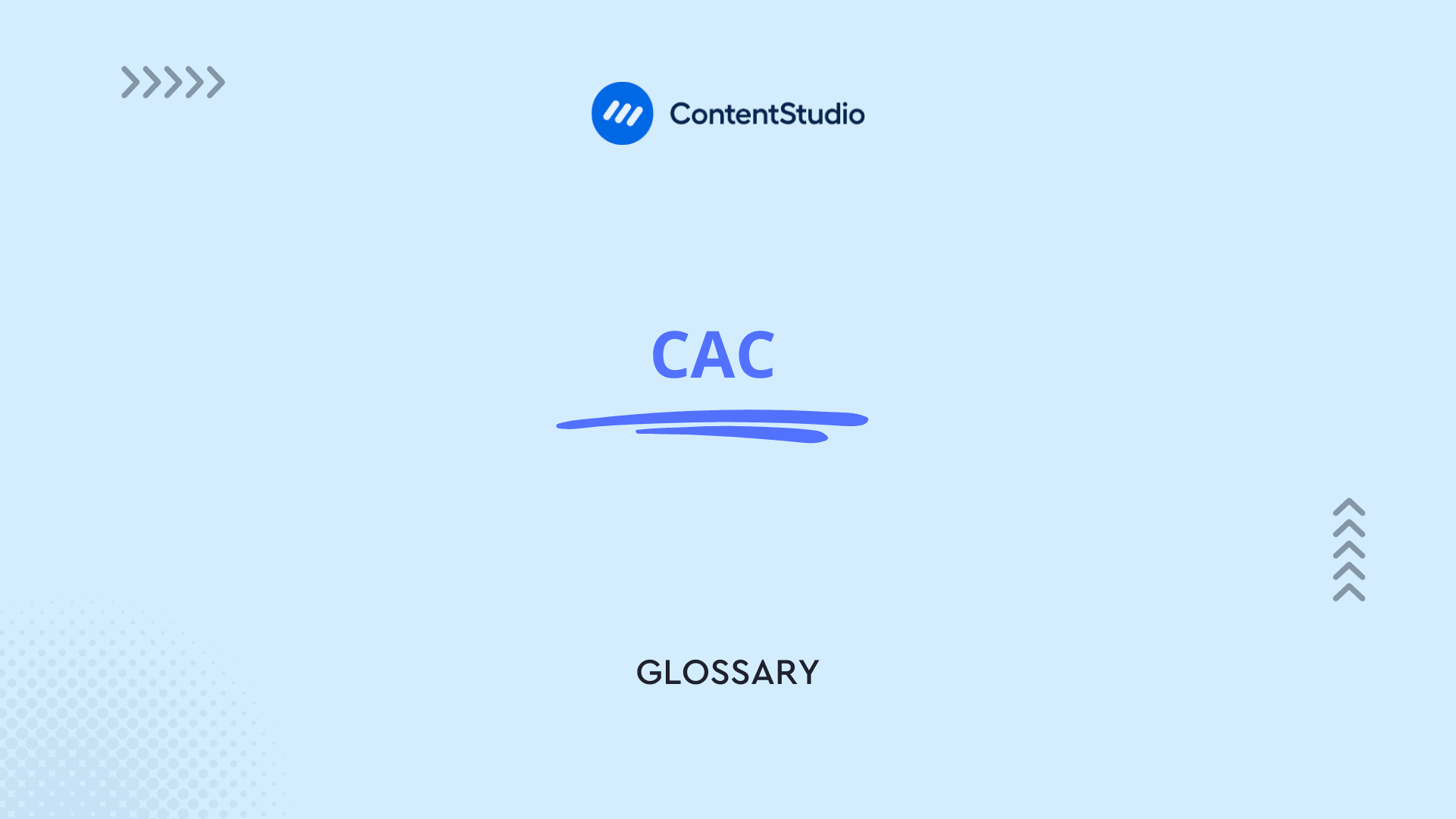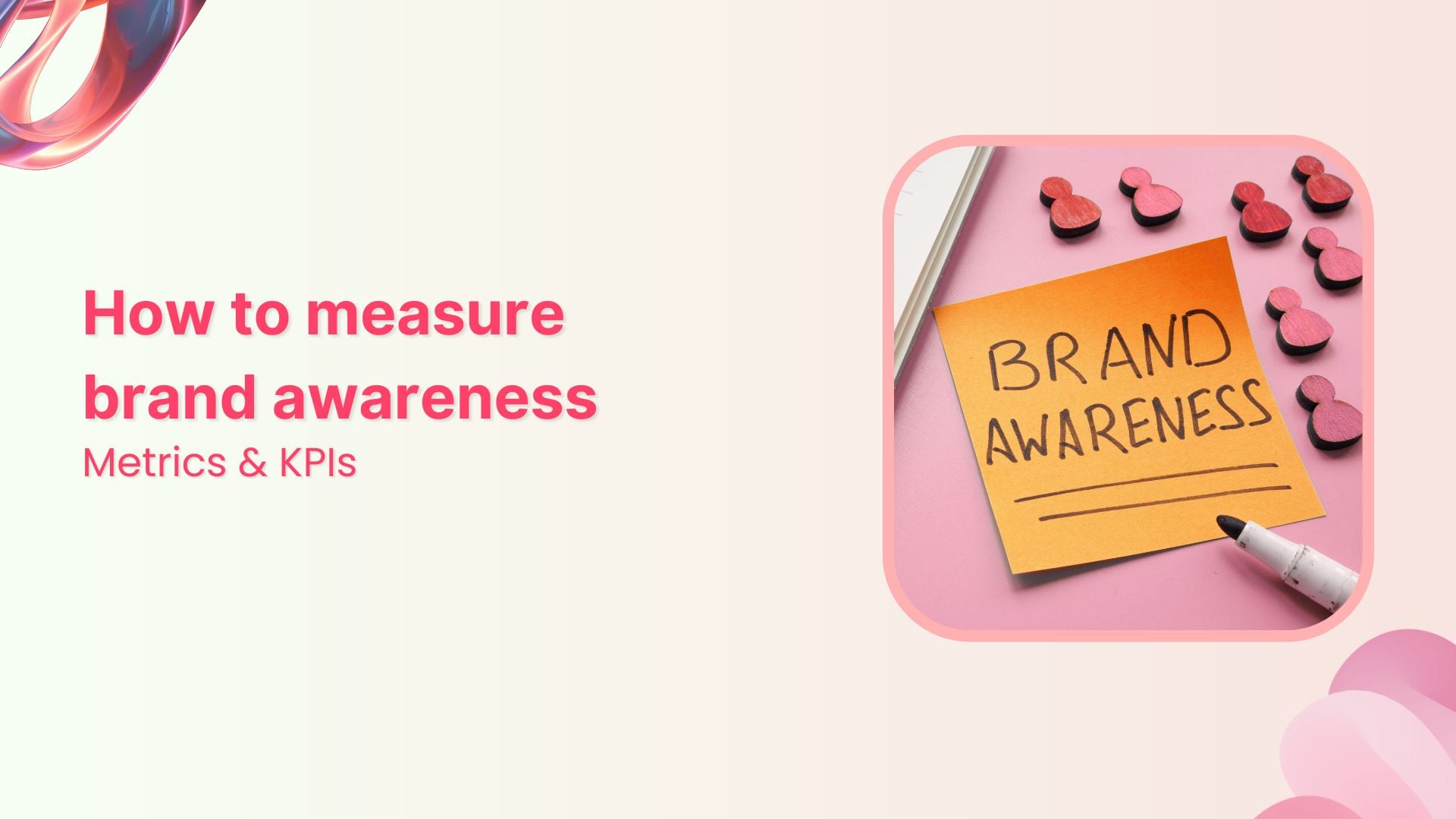Bulk-generate & schedule posts in seconds with Smart Scheduling. Try now!
CAC

What is CAC (Customer Acquisition Cost)?
Customer Acquisition Cost (CAC) represents the total cost a business incurs to acquire a new customer, including marketing expenses, sales efforts, and related overhead costs. This crucial metric helps businesses evaluate the efficiency of their marketing strategies and determine the return on investment (ROI) of their customer acquisition efforts.
How to calculate CAC?
The basic formula for calculating customer acquisition qost is:
Total Marketing and Sales Costs / Number of New Customers Acquired
For example, if your company spent $10,000 on marketing and sales efforts in a month and acquired 100 new customers, your CAC would be $100 per customer.
Components to include in acquisition costs
A comprehensive CAC calculation should include all expenses directly related to acquiring customers:
- Marketing expenses: All costs associated with marketing campaigns, including advertising spend, content creation, social media management tools like ContentStudio, and promotional activities
- Sales costs: Salaries and compensation for sales personnel, sales tools and technology, training expenses, and commission payments
- Related overhead: Portion of rent, utilities, and administrative costs that support marketing and sales functions
- Technology investments: Software costs for CRM systems, marketing automation platforms, and analytics tools
- Creative and content development: Expenses for creating marketing materials, including content creation and design work
Including all these components ensures that your CAC calculation reflects the true cost of acquiring customers, helping you make informed decisions about your acquisition strategy.
Why CAC matters for business growth
Customer Acquisition Cost is more than just a financial metric—it's a crucial indicator of business health and growth potential. Understanding why CAC matters helps contextualize its importance in your overall business strategy.
Profitability assessment
CAC directly impacts your business profitability:
- Customer Lifetime Value (CLV) ratio: The CLV ratio indicates how much value each customer generates compared to what it costs to acquire them. A healthy business typically maintains a CLV ratio of at least 3:1, meaning customers generate three times more value than their acquisition cost.
- Break-even analysis: CAC helps determine the payback period, which is the time it takes to recoup the cost of acquiring a customer.
- Pricing strategy validation: High CAC may indicate adjusting pricing to ensure profitability or improve retention to extend customer lifetime.
Understanding these relationships helps social media marketers justify marketing budgets and demonstrate the value of social media investments.
Benchmarking and competitive analysis
CAC serves as a valuable benchmark for performance evaluation:
- Industry comparisons: Different industries have varying CAC benchmarks due to market dynamics, competition, and product complexity.
- Competitive advantage: Lower CAC than competitors can indicate more efficient operations or stronger market positioning.
- Market maturity insights: Rising industry CAC often signals market saturation, while declining CAC may indicate growing market efficiency or innovative acquisition methods.
Tracking your CAC against industry standards helps contextualize your performance and identify opportunities for improvement in your marketing strategies.
Growth strategy planning
CAC influences key growth decisions:
- Scalability assessment: Rising CAC as you scale may indicate diminishing returns or the need to explore new channels.
- Market expansion evaluation: CAC projections help determine the feasibility of entering new markets or segments.
- Investor considerations: Investors often scrutinize CAC as an indicator of business efficiency and growth potential.
A clear understanding of your CAC trends helps develop sustainable growth plans and avoid costly expansion mistakes that could drain resources without proportional returns.
Factors that influence CAC
Multiple factors affect your Customer Acquisition Cost, both internally and externally. Recognizing these influences helps you address the root causes of high CAC rather than just the symptoms.
Market factors
External market conditions that impact CAC include:
- Competition intensity: More competitors typically drive up acquisition costs as businesses compete for the same customer base.
- Market awareness: In established markets with high product awareness, customers may be easier to acquire than in new markets requiring extensive education.
- Economic conditions: Economic downturns often increase CAC as consumers become more cautious with spending.
- Seasonal variations: Many industries experience seasonal fluctuations in CAC due to changing consumer behaviors and competitive intensity.
Understanding these external factors helps contextualize CAC changes that may be beyond your direct control but require strategic adaptation.
Product and pricing factors
Your product and pricing strategy significantly influence acquisition costs:
- Product complexity: Complex products typically require more education and longer sales cycles, increasing CAC.
- Price point: Higher-priced offerings often have higher CAC due to more extensive decision-making processes.
- Value proposition clarity: A clear, compelling value proposition can reduce acquisition costs by shortening the sales cycle.
- Product-market fit: Strong product-market fit naturally reduces acquisition costs as the offering resonates more readily with target customers.
Optimizing these elements can lower CAC without necessarily changing your marketing tactics, creating efficiencies throughout the customer journey.
Marketing and sales efficiency
Operational effectiveness in marketing and sales directly impacts CAC:
- Targeting precision: Well-defined buyer personas and precise targeting reduce wasted marketing spend.
- Channel optimization: Focusing on the most efficient acquisition channels improves overall CAC.
- Content effectiveness: High-quality, relevant content marketing can reduce CAC by better educating and nurturing prospects.
- Sales process efficiency: Streamlined sales processes with appropriate automation reduce the resources needed to convert leads.
- Marketing automation: Tools like ContentStudio can improve efficiency by automating repetitive tasks and enabling better content management across channels.
Regular analysis of these operational factors helps identify inefficiencies that may be artificially inflating your CAC.
Strategies to reduce CAC
Optimizing Customer Acquisition Cost requires a multifaceted approach that addresses various aspects of your marketing and sales operations. Here are effective strategies to reduce CAC while maintaining or improving acquisition results.
Improve targeting precision
Better targeting helps you focus resources on prospects most likely to convert:
- Refine audience segmentation: Create detailed customer segments based on behaviors, needs, and value to your business.
- Develop detailed personas: Build comprehensive buyer personas that guide all marketing and sales activities.
- Implement progressive profiling: Gradually collect more customer information to refine targeting over time.
- Leverage look-alike audiences: Use characteristics of your best customers to find similar prospects.
- Apply predictive analytics: Identify prospects with the highest conversion potential based on historical data patterns.
Using social media analytics tools can provide valuable data for refining your audience targeting and improving campaign performance.
Optimize marketing channels
Not all marketing channels deliver equal value. Optimize your channel mix for better efficiency:
- Conduct channel attribution analysis: Determine which channels contribute most effectively to conversions.
- Reallocate budget to high-performing channels: Shift resources from underperforming channels to those with lower CAC.
- Test emerging channels: Experiment with new platforms that may offer lower acquisition costs before competition increases.
- Refine channel-specific strategies: Tailor your approach to the unique characteristics of each channel rather than using a one-size-fits-all approach.
- Implement cross-channel coordination: Ensure your marketing efforts across channels work together harmoniously rather than in silos.
Tools like ContentStudio's social media management platform can help coordinate and optimize your presence across multiple channels from a centralized dashboard.
Enhance conversion rate optimization
Improving conversion rates naturally lowers CAC by getting more value from the same marketing spend:
- Optimize landing pages: Test and refine landing pages to increase conversion rates.
- Streamline the customer journey: Remove friction points that cause potential customers to abandon the process.
- Implement A/B testing: Continuously test different elements of your marketing to identify what resonates best with your audience.
- Improve call-to-action effectiveness: Craft compelling CTAs that drive higher response rates.
- Enhance mobile experience: Ensure your conversion paths work seamlessly on mobile devices.
Regular testing and optimization create incremental improvements that can significantly reduce CAC over time.
Leverage content and inbound marketing
Content marketing can substantially lower CAC by attracting interested prospects organically:
- Create valuable, targeted content: Develop content that addresses specific pain points and questions of your ideal customers.
- Establish thought leadership: Position your brand as an authority through high-quality content creation.
- Optimize for SEO: Improve organic visibility to reduce paid acquisition dependence.
- Implement content repurposing: Maximize the value of your content by adapting it for different formats and channels.
- Develop self-service resources: Create resources that allow prospects to educate themselves before engaging with sales.
Using content curation tools can help maintain a consistent flow of valuable content while reducing the resources required for creation.
Implement referral and advocacy programs
Customer referrals typically have among the lowest acquisition costs:
- Create structured referral programs: Develop systematic approaches to encourage and reward customer referrals.
- Incentivize advocates: Offer meaningful rewards for successful referrals.
- Simplify the referral process: Make it easy for customers to refer others through various channels.
- Leverage social proof: Highlight testimonials and case studies to build trust with prospects.
- Engage with brand mentions: Monitor and respond to brand mentions across social platforms to amplify positive sentiment.
Social media monitoring tools can help identify and engage with brand advocates across different platforms.
CAC vs. other key business metrics
While important on its own, CAC is most valuable when analyzed in relation to other business metrics. Understanding these relationships provides a more complete picture of your marketing effectiveness and business health.
CAC and Customer Lifetime Value (CLV)
The relationship between CAC and CLV is perhaps the most critical for assessing business sustainability:
- CLV ratio: This ratio shows how much value a customer generates relative to their acquisition cost. A healthy ratio is typically 3:1 or higher.
- CAC payback period: This metric indicates how long it takes to recoup the cost of acquiring a customer. Shorter payback periods generally indicate healthier unit economics.
- Margin-adjusted analysis: Consider profit margins when evaluating the CLV relationship for a more accurate view of profitability.
Analyzing these relationships helps determine if your acquisition strategy is economically sustainable in the long term and identifies opportunities for improving the balance.
CAC and retention metrics
Customer retention significantly impacts the effective CAC by extending customer lifetime:
- Churn rate impact: High churn rates effectively increase the real cost of acquisition since customer value is cut short.
- Expansion revenue: Additional revenue from existing customers (upsells, cross-sells) improves the CAC ratio without new acquisition costs.
- Net revenue retention: This metric shows how well you retain and grow revenue from existing customers, directly affecting the return on initial acquisition investment.
Improving retention can be more cost-effective than reducing CAC, as it maximizes the value derived from existing acquisition investments.
CAC and growth metrics
CAC interacts with various growth metrics to indicate overall business health:
- CAC ratio trend: Watching how this ratio changes over time indicates whether growth is becoming more or less efficient.
- CAC payback period trend: An increasing payback period may signal declining efficiency even if absolute CAC remains stable.
- Revenue growth rate vs. CAC growth rate: Ideally, revenue should grow faster than CAC. If CAC growth outpaces revenue growth, it may indicate diminishing returns on marketing investment.
These trend analyses help forecast whether current growth strategies are sustainable or require adjustment.
CAC for different business models
Customer Acquisition Cost varies significantly across different business models, each with unique considerations and benchmarks.
SaaS and subscription businesses
Subscription-based businesses face specific CAC challenges and opportunities:
- Higher initial CAC tolerance: The recurring revenue model often justifies higher upfront acquisition costs.
- Free trial and freemium impacts: These models can lower initial friction but may lengthen the overall conversion cycle.
- Expansion revenue opportunity: The ability to generate additional revenue from existing customers creates a "negative churn" effect that enhances CLV.
- Self-service vs. enterprise considerations: Self-service models typically have lower CAC but may also have lower CLV, while enterprise models have higher CAC but significantly higher CLV.
For SaaS businesses, effective social media management and content marketing are often key to reducing CAC through educational content and community building.
E-commerce businesses
Online retailers have unique CAC dynamics:
- Repeat purchase value: A Higher initial CAC may be justified for products with high repurchase rates.
- Basket size considerations: Higher average order values help offset acquisition costs more quickly.
- Seasonal fluctuations: Many e-commerce businesses face significant seasonal CAC variations.
- Marketplace vs. direct site acquisition: Marketplace presence may offer lower initial CAC but with platform fees that affect overall profitability.
E-commerce businesses can particularly benefit from social media marketing and content strategies that showcase products and build community.
Service-based businesses
Professional service firms face their own CAC challenges:
- Relationship-driven acquisition: The high-touch nature of service businesses often results in higher CAC but also higher CLV.
- Thought leadership importance: Establishing authority through content and speaking engagements is often key to reducing CAC.
- Referral dependency: Many service businesses rely heavily on referrals, making advocacy programs especially valuable.
- Long sales cycles: Extended decision processes require sustained marketing efforts that increase CAC.
For service businesses, building authority on platforms like LinkedIn and through content marketing is often crucial to justifying higher acquisition costs.
Measuring and tracking CAC effectively
To derive maximum value from CAC analysis, you need systematic approaches to measurement, tracking, and reporting. Establishing these systems creates a foundation for ongoing optimization.
Setting up tracking systems
Implement comprehensive tracking to capture all acquisition-related data:
- UTM parameter implementation: Use UTM parameters consistently across all marketing activities to track traffic sources.
- Multi-touch attribution models: Consider all touchpoints in the customer journey, not just the last click before conversion.
- CRM integration: Connect marketing analytics with your CRM to track prospects through the entire funnel.
- Conversion tracking setup: Implement proper conversion tracking across all relevant platforms and channels.
- Cost data consolidation: Create systems to aggregate all marketing and sales expenses for accurate CAC calculation.
Tools like ContentStudio's analytics features can help track performance across multiple social channels from a single dashboard.
Reporting and visualization
Make CAC data accessible and actionable through effective reporting:
- Regular reporting cadence: Establish consistent reporting periods that align with your business cycles.
- Trend visualization: Create charts showing CAC trends over time and across channels.
- Segmentation views: Break down CAC by customer segments, acquisition channels, and campaigns.
- Dashboard creation: Develop executive dashboards that place CAC in context with other key metrics.
- Benchmark comparisons: Include industry benchmarks and historical performance for context.
Clear visualization helps stakeholders quickly understand CAC performance and make informed decisions.
Continuous optimization process
Establish a systematic approach to ongoing CAC improvement:
- Regular review cycles: Schedule periodic deep dives into CAC performance.
- Experimentation framework: Develop a structured approach to testing new acquisition strategies.
- Success metrics definition: Clearly define what constitutes improvement beyond just lower CAC.
- Cross-functional input: Include perspectives from marketing, sales, product, and finance teams in optimization discussions.
- Closed-loop feedback: Create mechanisms to apply insights from existing customers to acquisition strategies.
This continuous improvement approach ensures CAC optimization becomes an ongoing process rather than a one-time initiative.
Conclusion
Understanding and optimizing customer acquisition costs is crucial for business success. By leveraging the right tools and strategies, businesses can maintain healthy CAC while growing their customer base effectively. Regular monitoring, analysis, and adjustment of acquisition strategies ensure sustainable growth and profitability.

Create, plan, schedule, and publish posts on all social media networks
Recommended for you


Powerful social media management software
14-day free trial - No credit card required.


